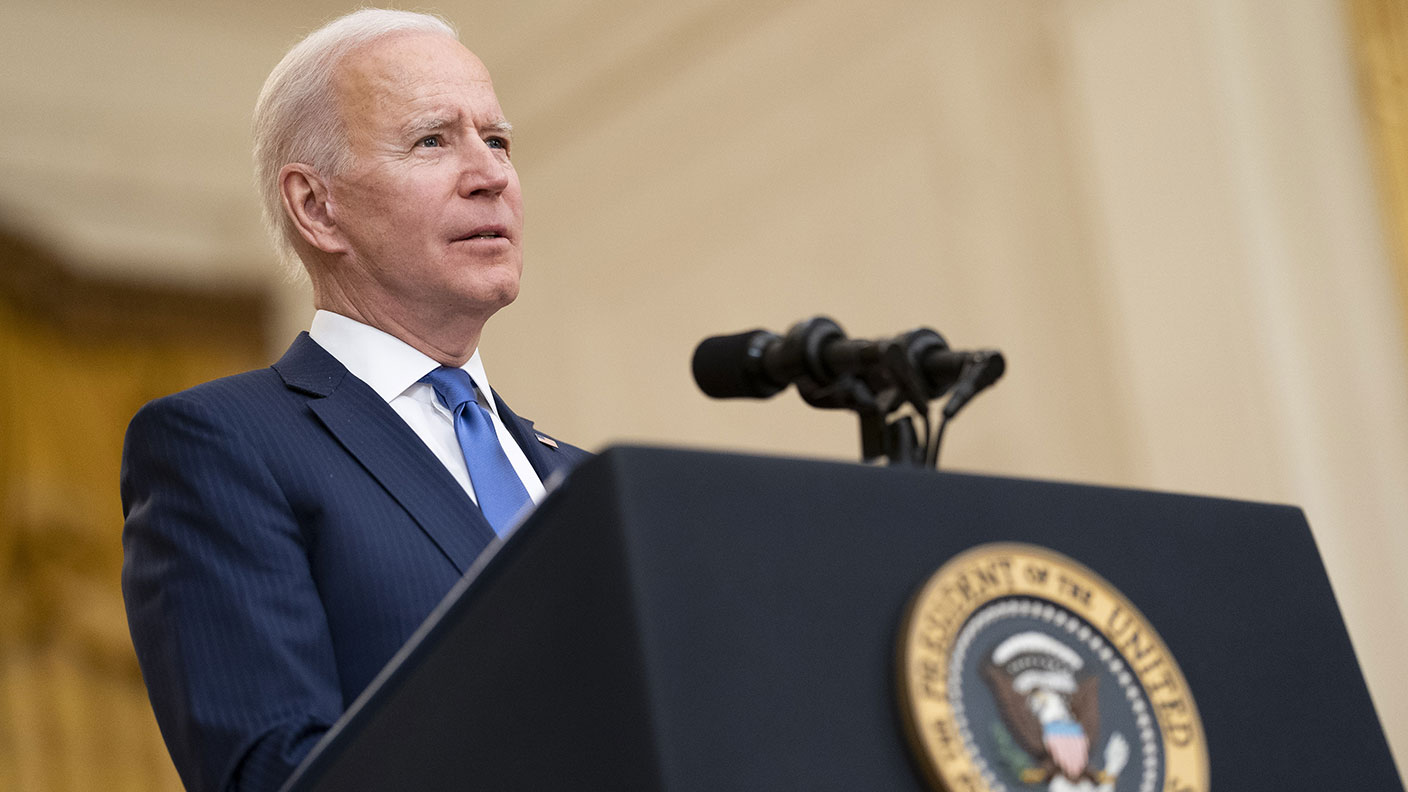What Joe Biden’s $1.9trn stimulus plan means for the US
The US just approved Joe Biden’s $1.9trn stimulus plan after months of political wrangling. Saloni Sardana looks at what's in it and how it could affect the US economy.


The US just passed a $1.9trn Covid-19 stimulus package – the so-called “American Rescue Plan” – made up of $1,400 payments to individuals, vaccine spending and much more.
The plan was approved by the Senate, the upper chamber of the Congress, over the weekend. Yesterday it was passed by the House of Representatives after a lengthy debate in a 220 to 211 vote. All but one Democrat voted for it; all Republicans voted against it.
US president Joe Biden is expected to sign the legislation as soon as he receives it ahead of the 14 March deadline when most current federal unemployment Covid benefits are expected to expire.
MoneyWeek
Subscribe to MoneyWeek today and get your first six magazine issues absolutely FREE

Sign up to Money Morning
Don't miss the latest investment and personal finances news, market analysis, plus money-saving tips with our free twice-daily newsletter
Don't miss the latest investment and personal finances news, market analysis, plus money-saving tips with our free twice-daily newsletter
What does the flagship plan include?
The package is one of the most generous US government interventions in post-war history, and will see most Americans receive direct payments of up to $1,400 (the payments are means-tested but set at a level well above the average household income); a $300-a-week boost in unemployment benefits which will run into September; and payments worth $250-$300 to parents who have children under the age of 18.
Both President Biden and the US Treasury have pledged to distribute the one-off direct payment to roughly 160 million US citizens within days of the bill being turned into law.
The plan marks the third time the US government has sent money direct to individuals since the start of the Covid-19 pandemic. Previous Covid relief packages included a $1,200 cheque in spring and a $600 cheque at the end of last year.
The legislation also includes $14bn-worth of funding for the supply and distribution of vaccines, which the US hopes will allow it to meet its pledge of vaccinating every American adult by the end of May. Other key areas include $350bn of fiscal aid for state and local governments and $130bn of funding for primary and secondary schools, among other measures.
How will the plan affect markets?
The plan has prompted many banks and key economic organisations to upgrade their growth forecasts for both the US and global economy. The Paris-based Organisation for Economic Co-operation and Development (OECD) reckons that the package will not just boost growth in the US but globally, upgrading its forecast for 2021 by 1.4 percentage points to 5.6%. It also expects the US economy to grow by 6.5% this year, significantly higher than the 3.3% it predicted in December.
Given the boost to global demand implied by an American consumer flush with cash and keen to spend it after a year on semi-lockdown, the idea that US demand will boost growth makes sense. The question then, however, is will this demand boost run into supply constraints, and trigger a significant rise in inflation?
Some economists are concerned that this may be the point at which inflation does make a comeback. Economist and former US Treasury Secretary (under Bill Clinton) Larry Summers says the plan contains far more stimulus than is necessary. As a result, there’s a risk that inflation surges, pushing the Federal Reserve to raise interest rates sooner than expected. In turn, that could have a big impact on markets, which have been priced on the basis of lower-for-longer interest rates for a long time.
It’s clear that markets are starting to worry about inflation. Or more specifically, about the impact inflation could have on Fed policy. This year has seen investors in both government and corporate bonds hit with nasty (by bond market standards) losses, as yields have surged and so prices have fallen (bond yields move inversely to prices).
In short, markets are concerned that a stronger-than-forecast recovery will force the Fed to raise interest rates sooner than expected. In turn, that will reduce the present value of companies’ future cash flows, which means that markets will be willing to pay less of a premium for future growth. This is why we’ve already seen a slide in the price of hot tech stocks such as Tesla.
These concerns were not helped by Fed governor Jerome Powell’s speech at the Wall Street Journal Jobs Summit last week. Powell said that the Fed was monitoring a “broad range of financial conditions”, but nothing more explicit than that. Markets would rather have explicit reassurance that even if inflation starts to get out of hand, the Fed will continue to keep interest rates low. Powell implied that – but markets would like specific numbers.
There can be little doubt that all of this extra spending will help US GDP this year – it can hardly do otherwise. While inflation looks as though it’s remaining manageable – this week, markets were somewhat reassured to see the latest reading for core consumer price inflation undershoot expectations a little – market fears about interest rate rises will stay in the background, and the “great rotation” from “long-duration” assets to shorter-duration assets such as value stocks may continue in a relatively calm manner. But if those concerns rematerialise, the Fed may have to do more than just talk to avoid a heftier market sell-off.
Get the latest financial news, insights and expert analysis from our award-winning MoneyWeek team, to help you understand what really matters when it comes to your finances.
Saloni is a web writer for MoneyWeek focusing on personal finance and global financial markets. Her work has appeared in FTAdviser (part of the Financial Times), Business Insider and City A.M, among other publications. She holds a masters in international journalism from City, University of London.
Follow her on Twitter at @sardana_saloni
-
 ‘Why I have ditched my Help to Buy ISA for cash savings and the stock market’
‘Why I have ditched my Help to Buy ISA for cash savings and the stock market’Without the 25% bonus, my Help to Buy ISA is effectively redundant, says MoneyWeek writer Sam Walker.
-
 Is your inheritance tax allowance cut if you sell to downsize or sell your home to pay for care?
Is your inheritance tax allowance cut if you sell to downsize or sell your home to pay for care?Downsizing relief is a little-known benefit that could save your loved ones tens of thousands of pounds in inheritance tax after you’ve died.
-
 What's behind the big shift in Japanese government bonds?
What's behind the big shift in Japanese government bonds?Rising long-term Japanese government bond yields point to growing nervousness about the future – and not just inflation
-
 UK wages grow at a record pace
UK wages grow at a record paceThe latest UK wages data will add pressure on the BoE to push interest rates even higher.
-
 Trapped in a time of zombie government
Trapped in a time of zombie governmentIt’s not just companies that are eking out an existence, says Max King. The state is in the twilight zone too.
-
 America is in deep denial over debt
America is in deep denial over debtThe downgrade in America’s credit rating was much criticised by the US government, says Alex Rankine. But was it a long time coming?
-
 UK economy avoids stagnation with surprise growth
UK economy avoids stagnation with surprise growthGross domestic product increased by 0.2% in the second quarter and by 0.5% in June
-
 Bank of England raises interest rates to 5.25%
Bank of England raises interest rates to 5.25%The Bank has hiked rates from 5% to 5.25%, marking the 14th increase in a row. We explain what it means for savers and homeowners - and whether more rate rises are on the horizon
-
 UK inflation remains at 8.7% ‒ what it means for your money
UK inflation remains at 8.7% ‒ what it means for your moneyInflation was unmoved at 8.7% in the 12 months to May. What does this ‘sticky’ rate of inflation mean for your money?
-
 Would a food price cap actually work?
Would a food price cap actually work?Analysis The government is discussing plans to cap the prices of essentials. But could this intervention do more harm than good?
